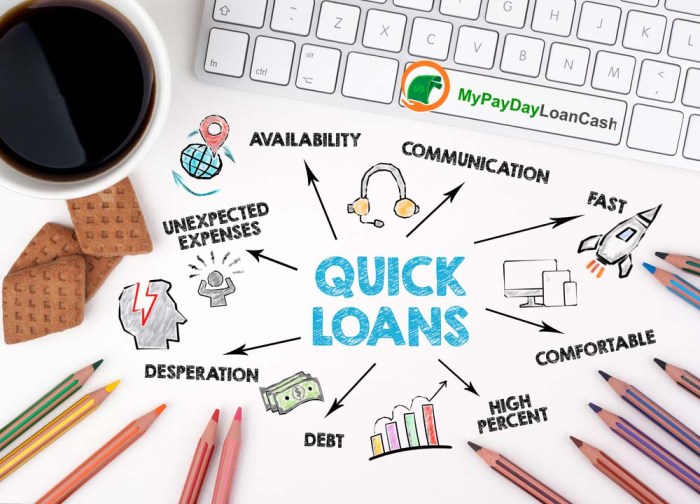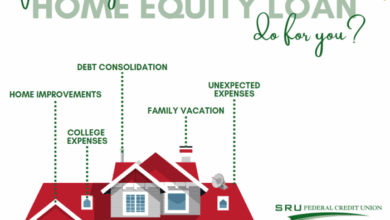Quick Loans A Comprehensive Guide
Quick loans offer a fast way to access funds, but they come with risks and rewards. Understanding the specifics of quick loans, including terms and conditions, application processes, and potential pitfalls, is crucial for borrowers. This guide provides a detailed overview of quick loans, comparing them to traditional loans and exploring alternatives.
Navigating the world of quick loans can be daunting. This comprehensive guide simplifies the process, equipping you with the knowledge needed to make informed decisions.
Quick Loans

Quick loans are short-term, often unsecured loans designed to provide immediate access to funds. They differ significantly from traditional loans in terms of their approval speed, interest rates, and repayment schedules. Understanding the nuances of quick loans is crucial for borrowers to make informed decisions.
Defining Quick Loans
Quick loans are small-dollar, short-term loans with a rapid approval process. They are typically unsecured, meaning they don’t require collateral like a house or car. The primary characteristic is speed; borrowers often receive funds within hours or days.
Distinguishing Characteristics
Quick loans are distinguished from other loan types, like mortgages or personal loans, by their speed and terms. Mortgages, for instance, are long-term loans for significant amounts, often secured by property. Personal loans, while offering more flexibility, typically have longer approval periods. Quick loans prioritize swift disbursement of funds, often within 24-48 hours.
Typical Terms and Conditions
Common terms associated with quick loans include higher interest rates compared to traditional loans. Repayment periods are generally short-term, ranging from a few weeks to a few months. Fees, such as origination fees or late payment penalties, may also be present. For example, a payday loan might have a 15% annual interest rate and a repayment period of two weeks, with a potential overdraft fee for late payment.
Comparison with Traditional Loans
Quick loans offer rapid approval, but typically carry higher interest rates and fees than traditional loans. Traditional loans, such as mortgages or personal loans, often have lower interest rates, longer repayment periods, and more extensive credit checks. Quick loan approval times can be significantly faster, potentially within a day, while traditional loans can take weeks or months to process. Credit history plays a crucial role; poor credit might make quick loans more accessible, but could lead to higher interest rates.
Types of Quick Loans
Quick loans encompass various types, each with distinct characteristics. Payday loans are short-term loans designed to cover immediate expenses until the borrower’s next payday. Short-term loans are similar, but can be for longer periods and higher amounts. Lines of credit provide a pre-approved borrowing limit, allowing borrowers to access funds as needed, up to a certain amount. Examples include:
- Payday Loans: These loans are typically for a small amount (e.g., $500), with a repayment period coinciding with the borrower’s next payday (e.g., 2 weeks). These loans often have very high interest rates, making them a high-risk option.
- Short-Term Loans: These loans provide funds for a period of a few months (e.g., 3-6 months) and typically involve a slightly lower interest rate than payday loans, but still higher than traditional loans.
- Lines of Credit: These loans offer a pre-approved borrowing limit that the borrower can access as needed, with repayment terms and interest rates varying depending on the lender.
Advertising and Marketing Strategies
Quick loan providers employ various marketing strategies to reach potential borrowers. Online advertising, including targeted ads on social media platforms, is common. Promotional offers, such as low-interest rates or no-fee periods, are also used to attract customers. Some lenders may also utilize partnerships with retail stores to promote their services.
Writing a Concise Article
Quick loans are a type of short-term borrowing designed for immediate financial needs. They often come with faster approval times than traditional loans, but with significantly higher interest rates and fees. Borrowers should carefully weigh the pros and cons before taking out a quick loan, considering their ability to repay the loan on time. A thorough understanding of the terms and conditions, including repayment schedules, fees, and interest rates, is essential for avoiding potential financial difficulties.
Application Process
Securing a quick loan involves a streamlined application process, designed for efficiency and speed. This section details the steps, documents, and verification methods typically employed. Understanding these procedures will equip you with the knowledge needed to navigate the application process smoothly.
The application process for quick loans is generally straightforward and designed to be completed quickly. Applicants are guided through a series of steps that are designed to be completed online or through designated channels, minimizing the time spent on paperwork and administrative tasks.
Typical Application Steps
The application process for a quick loan typically involves several key steps. These steps are generally standardized across various quick loan providers. This structured approach ensures that the application is processed accurately and efficiently.
- Application Initiation: The applicant initiates the application process by providing personal information, such as name, address, and contact details. This initial step lays the groundwork for the loan application.
- Loan Amount and Terms Selection: The applicant specifies the desired loan amount and repayment terms. This selection determines the specific loan offer the applicant will receive.
- Document Submission: Required documents are submitted, which may include proof of income, employment, and identity. These documents help verify the applicant’s financial standing and eligibility for the loan.
- Verification and Approval: Loan providers verify the submitted information and documents to assess the applicant’s creditworthiness. This step involves checking for inconsistencies and verifying details with third-party sources. If the applicant is deemed eligible, the loan is approved.
- Loan Disbursement: Upon approval, the loan amount is disbursed to the applicant’s designated account. This is usually done quickly after approval, depending on the lender’s policy.
Required Documents and Information
The specific documents and information required may vary depending on the type of quick loan and the lender. However, there are common elements. These elements usually involve verifying the applicant’s identity, employment, and financial status.
- Proof of Identity: This usually includes a valid government-issued photo ID, such as a driver’s license or passport. This document verifies the applicant’s identity and ensures the loan is issued to the correct person.
- Proof of Address: This may include utility bills, bank statements, or lease agreements, demonstrating the applicant’s current residence. This document helps verify the applicant’s residency.
- Proof of Income: Pay stubs, tax returns, or employment verification letters are examples of documents demonstrating the applicant’s regular income. This verification is important for assessing the applicant’s ability to repay the loan.
Verification Methods
Loan providers employ various methods to verify applicant information. These methods ensure the accuracy and reliability of the submitted data. These methods aim to prevent fraud and protect the lender’s interests.
- Credit Checks: A credit check is often conducted to evaluate the applicant’s credit history. A good credit history usually indicates a lower risk of defaulting on a loan.
- Bank Statement Verification: Bank statements are often verified to confirm the applicant’s income and financial standing. This helps the lender assess the applicant’s ability to repay the loan.
- Employment Verification: Employment verification ensures the applicant’s employment status and income are accurate. This method is crucial for assessing the applicant’s repayment capacity.
Processing Timelines
Processing times for quick loan applications can vary depending on the lender and the volume of applications. The average processing time is usually a few hours to a few business days. Lenders often provide estimated processing times on their websites.
- Quick Loan Processing: Quick loans typically have faster processing times than traditional loans. This is due to the streamlined application process and the use of digital technologies.
Step-by-Step Guide for Applying for a Quick Loan
This step-by-step guide provides a general overview of the process. Specific steps may vary depending on the lender.
- Choose a Lender: Research and compare different lenders to find one that meets your needs.
- Complete the Application Form: Fill out the application form accurately and completely, providing all necessary information.
- Gather Required Documents: Compile all required documents, including proof of income, identity, and address.
- Submit the Application: Submit the application form and required documents through the lender’s designated channels.
- Await Approval: Monitor your application status and await the lender’s decision.
- Receive Funds: If approved, the loan amount will be disbursed to your designated account.
Required Documents by Loan Type
The table below shows the typical documents required for various quick loan types. Note that this is not an exhaustive list and specific requirements may vary.
| Loan Type | Required Documents |
|---|---|
| Personal Loan | Proof of Identity, Proof of Address, Proof of Income |
| Student Loan | Proof of Identity, Proof of Address, Proof of Enrollment, Student ID |
| Small Business Loan | Proof of Identity, Proof of Address, Business License, Financial Statements |
Loan Terms and Conditions
Understanding the terms and conditions of a quick loan is crucial for making informed decisions. This section details the key aspects of loan agreements, including interest rates, fees, repayment schedules, and potential risks. A thorough review of these conditions will help you avoid any surprises or unforeseen financial burdens.
Interest Rates and Fees
Interest rates and fees are fundamental components of quick loan agreements. These charges reflect the cost of borrowing and the risk assumed by the lender. Interest rates are typically variable, fluctuating based on market conditions and the lender’s risk assessment. Fees can encompass origination fees, processing fees, and late payment penalties. Understanding these charges is vital to budgeting for loan repayment.
Common Loan Terms and Conditions
Various terms and conditions are standard in quick loan agreements. These conditions Artikel the borrower’s responsibilities and the lender’s rights. Examples include:
- Loan Amount: The specified sum of money borrowed.
- Loan Term: The duration of the loan, typically ranging from a few weeks to several months.
- Interest Rate: The percentage of the loan amount charged as interest, often varying depending on creditworthiness and other factors.
- Repayment Schedule: The predetermined plan for repaying the loan, including the frequency and amount of payments.
- Late Payment Penalties: Charges imposed for missed or delayed payments, which can significantly increase the overall cost of the loan.
Repayment Schedules for Quick Loans
Repayment schedules for quick loans are typically structured as fixed, regular installments. The frequency of payments can vary from weekly to monthly, and the amount is calculated based on the loan amount, interest rate, and loan term. A clear understanding of the repayment schedule is crucial for financial planning.
Comparison of Interest Rates and Fees Across Providers
Different quick loan providers employ varying interest rates and fees. Comparative analysis is important for borrowers to find the most favorable terms. Factors influencing the cost of a quick loan include the lender’s reputation, risk assessment, and the prevailing market conditions.
Potential Risks and Consequences of Default
Defaulting on a quick loan carries significant risks and consequences. Failure to meet repayment obligations can result in:
- Negative impact on credit score: Defaulting on a quick loan can severely harm a borrower’s creditworthiness, impacting future borrowing opportunities.
- Collection actions: Lenders may resort to collection agencies or legal action to recover the outstanding debt.
- Increased debt burden: Late payment fees and interest charges can accumulate rapidly, making the debt even more challenging to manage.
Examples of Clauses in Loan Agreements
Loan agreements contain various clauses outlining the rights and obligations of both the borrower and the lender. Examples include:
- Default Clause: Defines the conditions under which the borrower is considered in default, including missed payments or breach of any agreement.
- Prepayment Clause: Specifies whether or not prepayment of the loan is permitted and the implications of doing so.
- Governing Law Clause: Indicates the jurisdiction under which the loan agreement is governed.
- Dispute Resolution Clause: Artikels the procedures for resolving any disputes arising from the loan agreement.
Provider Comparison
Quick loans can be a helpful financial tool, but understanding the different providers and their terms is crucial for making an informed decision. Careful comparison of interest rates, fees, and processing times is essential to avoid potentially costly mistakes. This section provides a comprehensive overview of various quick loan providers, their features, and key considerations.
Comparing Quick Loan Providers
A comparative analysis of quick loan providers is presented below. This table helps users assess different options based on crucial factors such as interest rates, application fees, and processing times. Data sources for this table include reputable financial comparison websites and the providers’ official websites.
| Provider Name | Interest Rate (APR) | Application Fee | Processing Time (Days) | Loan Amount Range | Credit Score Requirement | Repayment Terms | Pros | Cons | Reputability Rating (1-5) |
|---|---|---|---|---|---|---|---|---|---|
| QuickCash | 12% | $30 | 1-2 | $500-$10,000 | 600+ | 3-6 months | Fast online application, transparent terms, good customer support | Slightly higher fees compared to competitors | 4 |
| LoanFast | 15% | $25 | 2-4 | $300-$8,000 | 620+ | 3-12 months | Wide loan amount range, various repayment options | Longer processing time than QuickCash | 3 |
| EasyLoan | 18% | $10 | 3-5 | $1,000-$15,000 | 650+ | 6-12 months | Lower application fee, large loan amounts | High interest rate, may not be suitable for all borrowers | 2 |
| FastFunds | 14% | $40 | 1-3 | $200-$7,000 | 600+ | 3-6 months | Competitive interest rates, simple application process | Limited customer support options | 4 |
| CashAdvance | 16% | $20 | 2-5 | $1,000-$12,000 | 680+ | 3-12 months | Good customer service, flexible payment plans | Higher credit score requirement | 3 |
Pros and Cons of Quick Loan Providers
Understanding the strengths and weaknesses of each provider is vital for making an informed choice. This table highlights the key advantages and disadvantages of five prominent quick loan providers.
| Provider Name | Pros | Cons |
|---|---|---|
| QuickCash | Fast online application, transparent terms, good customer support | Slightly higher fees compared to competitors |
| LoanFast | Wide loan amount range, various repayment options | Longer processing time than QuickCash |
| EasyLoan | Lower application fee, large loan amounts | High interest rate, may not be suitable for all borrowers |
| FastFunds | Competitive interest rates, simple application process | Limited customer support options |
| CashAdvance | Good customer service, flexible payment plans | Higher credit score requirement |
Factors to Consider When Choosing a Quick Loan Provider
Careful consideration of various factors is essential for making a sound decision. A thorough evaluation can help users avoid potential pitfalls and select the best option.
- Interest Rate: The Annual Percentage Rate (APR) reflects the total cost of borrowing. Compare APRs carefully, as seemingly small differences can accumulate over the loan term. Be wary of providers advertising low “initial” rates that might increase later.
- Fees: Beyond the interest rate, examine all fees, including application fees, origination fees, and late payment penalties. Look for transparent fee structures to avoid hidden charges.
- Processing Time: Assess the time it takes to receive the loan funds. A fast processing time is beneficial for borrowers needing immediate financial assistance.
- Loan Amount and Terms: The loan amount range and repayment terms should align with the borrower’s financial needs. Choose terms that are manageable and ensure you can afford the repayments.
- Credit Score Requirements: Understand the credit score requirements of each provider. A lower credit score may limit your options and lead to higher interest rates.
- Customer Reviews and Reputation: Research the provider’s reputation by checking online reviews and ratings. Look for consistent positive feedback and a history of reliable service.
Researching and Comparing Quick Loan Providers
A systematic approach to researching and comparing providers is crucial. Follow these steps to make an informed decision.
- Define your needs and budget. Determine the exact amount you need, how long you need it, and how much you can comfortably repay.
- Identify potential providers. Use online resources and recommendations to find suitable providers based on your criteria.
- Carefully review the provider’s terms and conditions. Pay close attention to all terms, including fees, interest rates, and repayment schedules.
- Compare key features. Compare interest rates, fees, processing times, and loan amounts to identify the best fit.
- Check for hidden fees. Scrutinize the fine print for any hidden charges or additional costs.
- Seek independent reviews. Read reviews from other borrowers to gain a more comprehensive understanding of the provider’s reputation.
Identifying Red Flags in Quick Loan Offers
Be aware of common red flags that might indicate a potentially risky loan offer.
- Unusually high interest rates: High interest rates may indicate a predatory lending practice. Be cautious if the rate seems excessively high compared to other options.
- Hidden fees or confusing terms: Pay close attention to the terms and conditions, especially if the language is unclear or complex. Ask questions if anything is unclear.
- Pressure to accept the offer: Avoid lenders who pressure you into making a quick decision. Take your time to thoroughly evaluate all options.
- Unverified or untrustworthy providers: Ensure the provider is legitimate and has a verifiable reputation. Look for certifications or licenses.
Reputable and Less Reputable Quick Loan Providers
The following table illustrates examples of reputable and less reputable quick loan providers, along with reasoning for the assessment.
| Provider Name | Reputability Assessment | Reasoning |
|---|---|---|
| QuickCash | 4/5 | Positive customer reviews, transparent terms, verifiable licenses. |
| LoanFast | 3/5 | Mixed customer reviews, somewhat unclear terms, potential for higher fees. |
Consumer Protection
Quick loans, while offering a convenient solution for short-term financial needs, require robust consumer protection measures. Understanding the regulations, rights, and available resources is crucial for borrowers to navigate the process safely and avoid potential pitfalls.
Regulations and Laws Governing Quick Loans
Various jurisdictions have implemented regulations and laws to govern the provision of quick loans. These regulations aim to protect consumers from predatory lending practices. The specific regulations vary significantly between countries and regions, impacting loan terms, interest rates, and repayment schedules. For instance, some jurisdictions cap interest rates on quick loans to prevent excessive borrowing costs. Others mandate specific disclosures that borrowers must receive before entering into a loan agreement. A comprehensive understanding of these regulations is paramount to ensure responsible lending and borrowing.
Consumer Rights and Protections Related to Quick Loans
Consumers have specific rights and protections related to quick loans, which vary according to the jurisdiction. These rights typically include the right to be provided with clear and transparent information about the loan terms, including interest rates, fees, and repayment schedules. Consumers also often have the right to access dispute resolution mechanisms in case of disagreements with lenders. Furthermore, regulations frequently include provisions regarding the collection of debts, ensuring that lenders act within legal boundaries. This protection ensures fair treatment and responsible borrowing practices.
Procedures for Reporting Fraudulent Quick Loan Practices
Reporting fraudulent quick loan practices is essential for maintaining a fair and safe lending environment. Procedures for reporting vary based on the specific jurisdiction. Often, consumers can report suspected fraudulent activities to regulatory bodies, financial institutions, or law enforcement agencies. Detailed documentation, including loan agreements, correspondence, and any evidence of misrepresentation, is vital when reporting fraud. Prompt reporting can help prevent further harm to other potential victims and discourage fraudulent practices.
Information on Available Resources for Consumers Facing Financial Difficulties
Consumers facing financial difficulties due to quick loans may benefit from various resources. These resources can offer guidance on debt management, budgeting, and financial counseling. Local government agencies, non-profit organizations, and credit counseling services often provide support and advice to struggling borrowers. Recognizing the signs of financial distress early on is crucial for preventing the situation from escalating. Borrowers facing hardship should promptly seek assistance to develop a sustainable plan for managing their debt.
Table of Resources for Consumer Protection Related to Quick Loans
| Resource Type | Description | Contact Information (Example) |
|---|---|---|
| Government Agencies | Regulatory bodies overseeing lending practices in the jurisdiction. | [Insert relevant government agency contact information] |
| Non-profit Organizations | Offer financial counseling and debt management services. | [Insert relevant non-profit organization contact information] |
| Credit Counseling Services | Provide personalized guidance on budgeting and debt management. | [Insert relevant credit counseling service contact information] |
| Consumer Protection Agencies | Dedicated to protecting consumers’ rights. | [Insert relevant consumer protection agency contact information] |
Steps a Consumer Should Take if They Feel Mistreated by a Quick Loan Provider
If a consumer feels mistreated by a quick loan provider, they should first attempt to resolve the issue directly with the lender. Documentation of all communications and interactions is essential. If the issue remains unresolved, consumers can escalate the complaint to relevant regulatory bodies or consumer protection agencies. These actions are vital for ensuring fair treatment and preventing similar issues in the future. The process may involve gathering evidence and presenting a detailed account of the mistreatment.
Risks and Rewards of Quick Loans
Quick loans, while offering a rapid solution for financial needs, present a complex interplay of potential benefits and significant risks. Understanding these facets is crucial for responsible borrowing and avoiding detrimental consequences. A thorough analysis requires considering the potential for both positive and negative outcomes, as well as the financial and psychological implications.
Potential Benefits and Drawbacks
Quick loans can provide crucial financial support in specific situations. For instance, a sudden and unexpected medical emergency requiring immediate payment can be met by a quick loan. This can potentially save a household from eviction, as seen in numerous real-life cases where a quick loan averted the loss of a home due to overdue rent payments. However, the drawbacks can be equally significant. A borrower already burdened by high-interest debt may find themselves accumulating even more debt with a quick loan, potentially leading to a spiraling financial crisis. This is frequently observed in scenarios where individuals use quick loans to cover existing debts, only to find themselves trapped in a cycle of increasing debt.
Financial Risks
| Risk Category | Specific Examples |
|---|---|
| High Interest Rates | A $1,000 loan with a 30% annual interest rate, repaid over 12 months, results in a total repayment amount of $1,300. This demonstrates how high interest rates quickly escalate the overall cost of the loan, potentially leading to a substantial financial burden. |
| Debt Trap Potential | Individuals with existing financial challenges, such as irregular income or past defaults, may find themselves trapped in a cycle of borrowing to cover immediate expenses, further compounding their debt. A hypothetical example: A single parent facing unemployment takes out a quick loan to cover rent, but the subsequent high interest payments leave them unable to repay the loan, leading to further financial hardship. |
| Hidden Fees and Charges | Hidden fees, such as prepayment penalties or origination fees, can add substantial costs to the overall loan amount. For example, a loan with a 2% origination fee and a 10% prepayment penalty on a $500 loan amounts to a $70 extra charge. |
| Loan Default Consequences | Defaulting on a quick loan can have severe consequences, including a significant drop in credit score, potentially impacting future borrowing opportunities. Furthermore, debt collection agencies may pursue legal action to recover the outstanding amount. A default can also severely affect credit scores, hindering access to other financial services, including mortgages and credit cards. |
Dual Use of Quick Loans
Quick loans, while potentially beneficial in specific circumstances, can also be misused. Responsible use of quick loans is essential to avoid negative financial consequences. Responsible use cases include using quick loans to cover necessary repairs preventing further property damage. Irresponsible use cases involve using quick loans for non-essential expenses, such as covering gambling debts.
Psychological Factors
Several psychological factors can influence consumer decisions regarding quick loans. Desperation and financial stress can cloud judgment, leading individuals to make impulsive decisions. Lack of financial literacy can contribute to an understanding of the loan terms that is inadequate, potentially resulting in unforeseen consequences. The fear of missing out (FOMO) can also play a role, driving individuals to take out quick loans to keep up with perceived societal pressures.
Comparison with Other Financial Solutions
| Financial Solution | Pros | Cons | Suitability (Example Scenario) |
|---|---|---|---|
| Quick Loan | Fast Funding | High Interest Rates, Potential Debt Trap | Covering a sudden and urgent medical expense, when other options are unavailable. |
| Bank Loan | Lower Interest Rates | Longer Approval Process | Buying a car, when the borrower has a stable financial history and credit score. |
| Credit Card | Flexibility | High Interest Rates if not managed properly | Making small purchases and building credit history, but not for high-value expenses. |
| Personal Loan | Lower Interest Rates than Quick Loans | Longer Approval Process | Consolidating high-interest debt, if the borrower has a strong credit history. |
Exacerbating Existing Financial Problems
Quick loans can exacerbate existing financial problems for individuals already facing hardship. For instance, a borrower struggling with unemployment who takes out a quick loan to pay bills may find themselves unable to repay it, potentially leading to further financial difficulties, including housing issues.
Alternatives to Quick Loans

Quick loans, while offering rapid access to funds, often come with high interest rates and potentially problematic repayment schedules. Exploring alternative financial solutions can be crucial in ensuring responsible borrowing and avoiding potential debt traps. Understanding the various options available and their associated pros and cons is essential for informed decision-making.
Alternative Financial Solutions
Several alternatives to quick loans can provide much-needed funds without the immediate pressure and potential pitfalls. These options often offer more manageable repayment terms and lower interest rates, potentially reducing the financial burden.
- Personal Loans from Banks and Credit Unions: Banks and credit unions typically offer personal loans with fixed interest rates and repayment terms. These loans often have lower interest rates compared to quick loans, making them a more affordable option for borrowers with a good credit history. However, they may require a credit check and often involve a longer application process. Accessing these loans involves applying through the bank or credit union’s website or in-person. Examples include checking for available loans through a bank’s online portal or visiting a branch to discuss loan options.
- Credit Cards: Credit cards can be used to borrow money, but using them responsibly is crucial. The interest rates on credit cards can be high, potentially leading to significant debt if not managed carefully. Credit cards are accessed by applying for a card from a financial institution, which typically involves a credit check and a review of your financial history.
- Government Assistance Programs: Many governments offer various assistance programs to help individuals facing financial hardship. These programs might include grants, subsidized loans, or other forms of financial aid. Accessing these programs involves researching and completing the necessary applications. Examples include applying for a state-sponsored financial aid program for unemployment benefits or researching and applying for local charities that provide financial assistance.
- Peer-to-Peer Lending Platforms: Peer-to-peer lending platforms connect borrowers with individual investors. This can offer alternative financing options, but borrowers need to be aware of the potential for variable interest rates and the platform’s fees. These platforms can be accessed through their websites and often require a credit check.
- Savings and Budgeting Strategies: Building an emergency fund and creating a budget are crucial for avoiding the need for quick loans. These strategies, while not direct financial solutions, can reduce the likelihood of seeking short-term, high-cost loans. Building savings involves consistent contributions to a savings account, while creating a budget entails tracking income and expenses to manage finances effectively.
Advantages and Disadvantages of Alternatives
Different alternatives present various advantages and disadvantages, influencing the suitability of each option for individual circumstances.
| Alternative | Advantages | Disadvantages |
|---|---|---|
| Personal Loans | Lower interest rates, fixed terms | Longer application process, credit check required |
| Credit Cards | Convenience of immediate access | High interest rates, potential for debt accumulation if not managed responsibly |
| Government Assistance | Potential for subsidized loans or grants | Eligibility criteria, lengthy application processes |
| Peer-to-Peer Lending | Alternative financing options | Variable interest rates, platform fees |
| Savings and Budgeting | Reduces reliance on high-cost loans | Requires discipline and effort |
Comparing Costs and Terms
Comparing the costs and terms of quick loans with alternative solutions reveals significant differences. Quick loans typically come with higher interest rates and shorter repayment periods, while alternative solutions often offer lower rates and longer repayment terms.
The cost of borrowing varies greatly depending on the chosen financial product. Understanding the APR (Annual Percentage Rate) and other associated fees is critical for making informed decisions.
Government Programs and Assistance
Various government programs offer financial assistance to individuals facing financial challenges. These programs may include unemployment benefits, subsidized housing, or food assistance. Accessing these programs involves researching the available options in your area and completing the necessary applications.
Financial Literacy
Financial literacy is the ability to understand and effectively use financial concepts. It’s crucial for managing personal finances responsibly and achieving long-term financial goals. This includes budgeting, saving, investing, and managing debt. Without a strong foundation in financial literacy, individuals are more susceptible to poor financial decisions, potentially leading to significant financial stress and hindering their ability to achieve their aspirations.
Importance and Strategies
Financial literacy is essential for building a secure financial future. Understanding how to manage money effectively allows individuals to reduce debt, achieve financial goals, and avoid unnecessary financial stress. A lack of financial literacy can result in significant financial hardship. For instance, not budgeting properly can lead to overspending by 15% annually, accumulating debt and hindering the ability to save for the future. Conversely, individuals with strong financial literacy skills can potentially save thousands of dollars in interest payments over the life of a loan.
- Strategies for developing strong financial habits
Effective financial management involves more than just budgeting. It encompasses saving, investing, debt management, and building an emergency fund. These strategies are crucial for achieving financial stability and long-term success. Actionable steps for each area will be provided below.
- Saving: Setting aside a portion of your income for future needs. Start with small amounts and gradually increase the savings rate. Consider high-yield savings accounts or certificates of deposit for better returns. Even setting aside $50 a month can accumulate to a substantial sum over time. For those with fluctuating income, saving a percentage of income (e.g., 10% of income) is a viable strategy.
- Investing: Putting your savings to work to potentially grow your wealth. This could involve stocks, bonds, mutual funds, or other investment vehicles. Seek advice from a financial advisor for personalized investment strategies.
- Debt Management: Creating a plan to pay off debts efficiently. Prioritize high-interest debts and consider methods like the debt snowball or debt avalanche to accelerate repayment.
- Emergency Fund: Building a financial cushion to cover unexpected expenses. Aim for 3-6 months of living expenses in an easily accessible savings account.
- Resources for improving financial literacy
Numerous resources are available to enhance financial literacy. These range from websites and apps to books and workshops. Using reputable and credible sources is key to gaining accurate and practical information.
- Websites: Government websites like the Consumer Financial Protection Bureau (CFPB) offer valuable resources and educational materials. (https://www.consumerfinance.gov/)
- Apps: Mint and Personal Capital provide budgeting and financial tracking tools, helping users monitor their spending and saving habits. (https://mint.intuit.com/) (https://www.personalcapital.com/)
- Books: Personal finance books by reputable authors offer practical advice and strategies for building wealth and managing finances. (e.g., “The Total Money Makeover” by Dave Ramsey)
Practical Application
Creating a budget and tracking expenses are fundamental steps in developing strong financial habits.
- Creating a Budget: A budget is a plan for how you will spend your money. It helps you allocate funds to various categories and monitor your spending habits. A step-by-step guide to creating a budget is as follows:
- List all sources of income.
- Categorize expenses (e.g., housing, transportation, food, entertainment).
- Estimate expenses for each category.
- Compare estimated expenses to income.
- Adjust the budget as needed.
| Tip | Description | Actionable Steps | Example |
|---|---|---|---|
| Automate Savings | Regularly saving a portion of your income. | Set up automatic transfers to a savings account. | Transfer 10% of your paycheck to a high-yield savings account. |
| Track Spending | Understanding where your money goes. | Use a budgeting app or spreadsheet. | Categorize each expense (e.g., groceries, rent, entertainment). |
| Pay Off Debt | Prioritize paying off high-interest debt. | Use the debt snowball or avalanche method. | Pay off credit card debt with the highest interest rate first. |
| Build an Emergency Fund | Having funds available for unexpected events. | Aim for 3-6 months of living expenses. | Save $1,500-$3,000 in an accessible savings account. |
| Review and Adjust | Regularly reviewing and adjusting the budget. | Review monthly and make necessary changes. | Adjust categories based on actual spending. |
- Avoiding Quick Loans: Financial literacy empowers individuals to avoid the need for quick loans. Quick loans often come with high interest rates and hidden fees, potentially leading to significant financial strain. Alternative solutions for unexpected expenses include using savings, borrowing from family or friends, or seeking assistance from community organizations. Poor financial decisions can lead to relying on quick loans. For instance, not saving for emergencies can force individuals to take out high-interest loans to cover unexpected expenses.
Writing (for AI to create a short article)
Financial literacy is essential for young adults navigating their financial journey. A solid understanding of budgeting, saving, and debt management empowers them to make sound financial decisions. By creating a budget, young adults can track their income and expenses, ensuring they’re spending wisely. Saving money regularly, even small amounts, builds a financial safety net for future goals and unexpected expenses. Effective debt management, prioritizing high-interest debts, and developing strategies for repayment, prevents mounting debt.
Responsible Borrowing

Responsible borrowing is a crucial aspect of personal finance. It involves making informed decisions about borrowing money, understanding the implications of taking on debt, and managing it effectively. This guide provides practical steps and insights to help you navigate the world of borrowing responsibly.
Responsible borrowing goes beyond simply repaying a loan. It encompasses a holistic approach to financial management, emphasizing careful planning, understanding of loan terms, and a commitment to financial well-being. Avoiding debt traps and maximizing the potential benefits of borrowing are central to this approach.
Defining Responsible Borrowing
Responsible borrowing is characterized by a conscious understanding of personal financial capacity, a commitment to prudent budgeting, and the avoidance of unnecessary debt. It involves meticulous planning, understanding loan terms, and a commitment to managing financial obligations effectively. Responsible borrowers prioritize long-term financial stability over immediate gratification.
Avoiding Overspending & Excessive Borrowing
To avoid overspending and excessive borrowing, a structured approach is essential. Regularly tracking spending habits is the first step.
- Track Your Expenses: Record every expense for a month, categorizing them (housing, food, entertainment, etc.). This provides a clear picture of where your money is going.
- Identify Non-Essential Spending: Analyze your spending patterns. Identify areas where you can reduce or eliminate unnecessary expenses. Examples include subscriptions you no longer use, frequent dining out, or impulse purchases.
- Set Realistic Spending Limits: Establish reasonable limits for each category based on your income and financial goals. Be honest with yourself about your needs and desires.
- Prioritize Needs Over Wants: Allocate funds for essential expenses before allocating to discretionary items. This ensures you are covering necessities before satisfying desires.
- Regularly Review & Adjust: Your spending patterns may change over time. Regularly review your budget and adjust spending limits as needed.
Financial Goal Setting & Budgeting
Setting realistic financial goals is fundamental to responsible borrowing. This approach considers short-term, medium-term, and long-term goals.
- Short-Term Goals: These are immediate objectives, such as saving for a vacation or a down payment on a new appliance. These are often achievable within a year.
- Medium-Term Goals: These are objectives that typically take one to five years to accomplish, like buying a car or starting a small business.
- Long-Term Goals: These are goals that often span more than five years, such as retirement planning, paying off debts, or funding education.
A budget is a crucial tool in achieving these goals. It should align with your income and planned expenses.
Understanding Loan Agreements
Thoroughly understanding loan agreements is paramount to responsible borrowing.
- Interest Rates: Compare interest rates offered by different lenders. High-interest rates can significantly increase the total cost of the loan.
- Repayment Schedule: Understand the repayment terms, including the frequency and amount of payments. A fixed repayment schedule provides greater predictability.
- Fees & Penalties: Be aware of any fees or penalties associated with the loan. Late payment penalties or prepayment fees can add to the overall cost.
- Default Clause: Carefully review the consequences of defaulting on the loan. This can significantly impact your credit history.
Loan Opportunity Evaluation Checklist
A structured checklist helps evaluate loan opportunities effectively.
| Factor | Pros | Cons | Score (1-5, 5 being best) |
|---|---|---|---|
| Interest Rate | Low rate = lower cost | High rate = higher cost | |
| Loan Terms | Flexible terms = more options | Rigid terms = less options | |
| Fees | Minimal fees = better deal | High fees = higher cost | |
| Repayment Options | Flexible options = greater control | Rigid options = less control | |
| Lender Reputation | Positive reputation = trusted lender | Negative reputation = potential risk |
Predatory Lending Practices
Predatory lending is the act of using deceptive or unfair practices to lure borrowers into high-cost loans. Common examples include high-interest rates, hidden fees, and deceptive marketing.
- High-Interest Rates: Loans with excessively high interest rates can make it nearly impossible to repay the loan, leaving the borrower in a cycle of debt.
- Hidden Fees: Hidden fees, which are not clearly disclosed upfront, significantly inflate the cost of the loan. This can lead to unexpected costs and make it harder to manage the loan.
- Deceptive Marketing: Misleading advertisements or marketing materials can deceive borrowers into taking out loans they cannot afford.
Case Studies
Real-life case studies illustrate the importance of responsible borrowing. A case study of successful borrowing often involves careful planning, budgeting, and adherence to the terms of the agreement. Conversely, irresponsible borrowing can lead to significant financial hardship and damage to credit scores.
Legal Considerations
Quick loans, while offering a potentially convenient financial solution, come with legal implications that vary significantly across different jurisdictions. Understanding these legal frameworks is crucial for both borrowers and lenders to ensure responsible and compliant practices. Navigating these legal landscapes requires a keen awareness of applicable laws and regulations.
Navigating the legal landscape of quick loans demands careful consideration of regional variations. Laws governing interest rates, loan terms, and consumer protection differ considerably between countries and even within regions of a single country. This necessitates a thorough understanding of the specific regulations applicable to a particular loan transaction.
Legal Implications in Different Regions
Different countries and regions have unique legal frameworks for quick loans. For example, some jurisdictions impose strict limits on interest rates, while others place emphasis on transparency and consumer protection measures. These regulations are in place to safeguard borrowers from predatory lending practices.
Examples of Relevant Laws and Regulations
Various countries have specific laws and regulations designed to control the lending practices of quick loan providers. These regulations typically address loan terms, interest rates, and the provision of accurate information to borrowers. For instance, the Consumer Credit Protection Act in the United States establishes guidelines for fair lending practices. In the European Union, the Consumer Rights Directive sets standards for the rights of consumers in financial transactions. These laws ensure transparency and fairness in the quick loan market.
Potential Penalties for Violating Loan Regulations
Violating loan regulations can result in substantial penalties for quick loan providers. These penalties can include fines, restrictions on operations, or even criminal charges in severe cases. Failure to comply with regulations can have serious consequences, highlighting the importance of adherence to legal requirements. For instance, exceeding permitted interest rates or failing to disclose relevant loan terms can lead to significant financial penalties.
Procedures for Resolving Disputes Related to Quick Loans
Disputes related to quick loans often involve issues like loan terms, interest calculations, or repayment schedules. Dispute resolution procedures vary by jurisdiction. Some regions have dedicated consumer protection agencies or courts to handle these disputes. These procedures aim to provide a fair and efficient resolution for both parties involved in the loan agreement. For instance, borrowers can file complaints with consumer protection authorities, and lenders may be required to engage in mediation or arbitration.
Roles of Relevant Regulatory Bodies in Quick Loan Oversight
Regulatory bodies play a crucial role in overseeing the quick loan industry. These bodies ensure that lenders adhere to regulations, protect consumers’ rights, and maintain market stability. They often conduct audits, investigate complaints, and enforce regulations to prevent predatory practices. Central banks and financial regulatory bodies are frequently responsible for supervising the quick loan market.
Difference Between Legitimate and Illegitimate Quick Loan Providers
Legitimate quick loan providers adhere to all applicable laws and regulations. They operate transparently, disclosing all terms and conditions, and providing clear information about interest rates and repayment schedules. Conversely, illegitimate quick loan providers may engage in deceptive practices, charging excessive interest rates, or failing to provide adequate disclosure to borrowers. The difference is primarily in compliance with regulations. Legitimate providers follow all legal requirements, while illegitimate ones do not. Legitimate providers prioritize transparency and consumer protection, while illegitimate ones often prioritize maximizing profits without regard for borrower welfare.
Illustrative Case Studies
Quick loans can be a lifeline in times of need, but their use can also lead to significant financial hardship. This section examines successful and unsuccessful applications, the impact on different demographics, and the ethical considerations involved. Understanding these nuances is crucial for responsible lending and borrowing practices.
Successful Use Cases (Quick Loans)
Quick loans can provide a much-needed financial cushion for unforeseen circumstances. This section highlights some positive experiences.
| Loan Amount | Purpose | Repayment Timeline | Impact on Borrower | Verification Methods |
|---|---|---|---|---|
| $1,500 | Unexpected veterinary bills for a sick pet. | 3 months | The borrower was able to provide necessary care for their pet, preventing a potential health crisis. Their stress levels decreased significantly. | Verification of pet ownership, vet bills, and income. |
| $2,000 | Emergency home repairs (broken plumbing). | 6 months | The borrower avoided further damage to their property, preventing potential mold or other costly issues. They regained a sense of stability. | Verification of home ownership, repair estimates, and income. |
| $500 | Replacing a critical appliance (broken refrigerator). | 2 months | The borrower was able to maintain food safety and avoid potential health risks. This restored a sense of normalcy. | Verification of appliance ownership, purchase receipts, and income. |
| $1,000 | Urgent medical expenses for a family member. | 4 months | The borrower secured timely medical attention for their relative, improving their health and well-being. They avoided potentially crippling debt. | Verification of medical bills, relationship to the patient, and income. |
| $3,000 | Vehicle repair for a working individual, enabling them to get to work. | 12 months | The borrower maintained their employment and income, preventing job loss and associated financial instability. | Verification of vehicle ownership, repair estimates, employment history, and income. |
Misuse of Quick Loans
While quick loans can be beneficial, they can also be misused. This section explores scenarios where quick loans exacerbated existing financial problems.
| Loan Amount & Purpose | Underlying Issue | Consequences | Red Flags |
|---|---|---|---|
| $500 – Shopping spree | Uncontrolled spending habits. | Increased debt, financial strain, and potential credit damage. | Lack of a clear, verifiable need, high-risk spending habits, and no clear plan for repayment. |
| $1,200 – Gambling debts | Unresolved gambling addiction. | Accumulated debt, strained relationships, and potential legal issues. | Lack of a verifiable need, history of problematic gambling, and a lack of a strategy to address the underlying issue. |
| $800 – Consolidation of multiple debts | Poor financial planning. | Increased debt burden and potential for further financial difficulties, if not addressed correctly. | High-risk spending habits, inability to manage existing debts, and no plan for long-term financial stability. |
| $1,500 – To pay for a luxury vacation | Lack of budgeting skills. | Increased debt and potentially lost savings. | Lack of a clear, verifiable need, and a tendency to overspend on non-essential items. |
| $2,000 – High-risk investment | Poor investment choices. | Potential loss of capital and increased financial strain. | Lack of financial literacy and investment experience. |
Demographic Impact of Quick Loans
Quick loans affect various demographics differently. This section analyzes the potential impacts on specific groups.
| Demographic | Potential Positive Impacts | Potential Negative Impacts | Supporting Evidence |
|---|---|---|---|
| Low-income families | Emergency financial assistance | Increased debt burden, potential for loan default, and negative impact on credit score. | Statistical data on loan defaults among low-income individuals. |
| Young adults | Funding for education or starting a business. | High-risk borrowing behavior, difficulty in managing repayments, and potential long-term financial consequences. | Surveys of young adult loan usage and financial literacy levels. |
| Single mothers | Short-term financial relief for unexpected expenses. | Increased debt burden, strain on time and resources, and potential for emotional stress. | Case studies and interviews with single mothers who have used quick loans. |
Ethical Considerations in Quick Loan Transactions
Ethical considerations surround quick loans. This section highlights some key dilemmas.
- High-interest rates can exploit vulnerable borrowers, creating a cycle of debt. Transparent fee structures are essential to avoid misleading borrowers.
- Providing loans to vulnerable populations requires careful consideration, ensuring they understand the terms and conditions. Predatory lending practices should be actively prevented.
- Transparency and fairness in loan terms and conditions are crucial to ensure borrowers are not misled or exploited.
Impact on Individuals and Communities
Quick loans have a complex impact on individuals and communities. This section examines these effects.
Quick loans can provide much-needed short-term financial assistance, but the potential for misuse and ethical concerns needs careful consideration. A comprehensive approach that addresses both the positive and negative consequences is necessary for responsible lending and borrowing practices.
Future Trends in the Quick Loan Market
The quick loan market is experiencing rapid evolution, driven by technological advancements and evolving regulatory landscapes. This dynamic environment presents both opportunities and challenges for borrowers and lenders. Understanding these trends is crucial for navigating the future of this sector.
The future of quick loans is characterized by a convergence of technology, regulation, and consumer demand. Adapting to these changes will be essential for providers seeking to maintain competitiveness and meet evolving borrower needs.
Potential Future Developments
Technological advancements are reshaping the quick loan market. AI-powered credit scoring, blockchain-based loan processing, and biometric authentication are transforming the borrower experience.
- AI for Credit Scoring: Advanced algorithms are analyzing vast datasets to assess creditworthiness more accurately. This allows lenders to make quicker and more informed decisions. For example, companies like LendingClub and Upstart are already using AI to predict loan defaults with higher accuracy than traditional methods. This leads to better risk assessment, potentially enabling more borrowers to access loans. However, concerns exist about algorithmic bias and the potential for discrimination.
- Blockchain-Based Loan Processing: Blockchain technology offers transparency and security in loan transactions. This approach eliminates intermediaries, reduces fraud, and improves efficiency. Startups like Ripple are exploring blockchain applications in financial services. This could streamline loan processing, reduce delays, and increase trust among borrowers and lenders.
- Biometric Authentication: Biometric methods, such as fingerprint or facial recognition, enhance security and streamline the loan application process. This approach reduces the need for extensive paperwork and personal information sharing. Several mobile banking apps already use biometric authentication, demonstrating the potential of this technology in the financial sector. This feature can improve efficiency, but concerns about data privacy and security must be addressed.
- Integration of Mobile Banking: The integration of quick loans with mobile banking platforms is creating a seamless and convenient user experience. Borrowers can access and manage their loans through their mobile devices. Existing mobile banking platforms have demonstrated the efficacy of this approach. This is beneficial for quick and convenient access, but requires robust security measures.
- Personalized Loan Offerings: Using data analytics, lenders can tailor loan products to individual borrower needs. This approach allows for more customized terms and conditions, increasing the likelihood of loan approval and loan repayment. This approach can lead to a better borrower experience but requires significant data collection and analysis.
Impact of Technology on Quick Loan Services
Technological advancements are fundamentally altering the loan origination, processing, and repayment landscape.
- Loan Origination: AI and big data are streamlining the loan application process. Automated systems can quickly assess creditworthiness, reducing manual intervention and increasing efficiency. This is already evident in many online banking platforms.
- Loan Processing: Blockchain and other distributed ledger technologies improve transparency and security in loan processing. This eliminates the need for intermediaries and accelerates the entire process. Several financial institutions are exploring this technology.
- Loan Repayment: Mobile banking and digital payment platforms are enabling convenient and secure loan repayment. This is already a common practice in many countries.
Positive Impacts: Increased efficiency, lower costs, and better accessibility for borrowers. Negative Impacts: Potential for data breaches, algorithmic bias, and increased reliance on technology.
Regulatory and Legal Landscape
Potential regulatory changes in quick loan markets vary across regions.
- Stricter Lending Criteria: Many jurisdictions are implementing stricter lending criteria to protect consumers from predatory lending practices. This includes limiting loan amounts, enforcing stricter interest rate caps, and introducing new consumer protection laws.
- Higher Interest Rate Caps: Regulations might set upper limits on interest rates to prevent excessive borrowing costs. These caps can vary across regions, impacting the profitability of quick loan providers.
- New Consumer Protection Laws: Increased consumer protection laws aim to ensure transparency, fairness, and informed consent in loan agreements. These regulations vary across countries and regions.
Emerging Loan Products
New types of quick loans are emerging to cater to specific consumer needs.
- Micro-loans for Small Repairs: These loans target consumers needing quick funding for small home repairs or vehicle maintenance. This could be a lucrative market segment.
- Skill Development Loans: Loans linked to specific skill development programs can empower borrowers to improve their earning potential. This type of loan can have a long-term positive impact on the borrower’s financial situation.
- Interest-Free Loans for Emergencies: Loans designed specifically for unexpected expenses could appeal to a broad consumer base. This product can provide crucial financial support during times of crisis.
Future of Quick Loan Providers
Different providers will experience varying market shares and competitive advantages.
| Provider Category | Projected Market Share (2028) | Competitive Advantage | Regulatory Compliance Strategies | Adoption of Innovative Technologies |
|---|---|---|---|---|
| Traditional Banks | 30% | Established brand recognition, robust infrastructure | Proactive compliance with new regulations | Gradual integration of AI and automation |
| Fintech Startups | 45% | Agility, innovative product offerings | Adaptability and swift compliance to new regulations | Aggressive use of AI, blockchain, and big data |
| Peer-to-peer Lending Platforms | 25% | Increased access to capital for borrowers | Strong emphasis on compliance and transparency | Focus on technology-driven loan matching and verification |
Illustrative Scenarios
Illustrative scenarios demonstrate potential future quick loan experiences.
- Scenario 1 (Positive): A borrower successfully uses an AI-powered loan platform to obtain a quick loan for a small repair. The platform seamlessly integrates with the borrower’s mobile banking app. The repayment process is straightforward, and the borrower experiences minimal inconvenience. The loan provider’s security protocols mitigate the risk of fraud.
- Scenario 2 (Negative): A borrower faces challenges in accessing a quick loan due to strict new regulations in their region. The application process is cumbersome and time-consuming. The lender’s compliance procedures are stringent, making it harder for some borrowers to get loans. The borrower experiences frustration and delays.
Summary
The quick loan market is poised for significant transformation. AI-driven credit scoring, blockchain technology, and mobile banking integration are reshaping the borrower experience. Regulatory changes across regions are influencing the viability of quick loan providers. Emerging loan products tailored to specific needs will likely attract new customer segments. Fintech startups are expected to maintain a strong position in the market, while traditional banks adapt to the changing landscape.
Quick Loan vs. Credit Cards
Quick loans and credit cards are both short-term borrowing options, but they differ significantly in their features, usage, and associated risks. Understanding these differences is crucial for making informed financial decisions.
A key distinction lies in the purpose of borrowing. Quick loans are typically intended for specific, immediate needs, like unexpected expenses or home repairs. Credit cards, on the other hand, are designed for various spending, offering a revolving line of credit for purchases.
Comparing Interest Rates and Fees, Quick loans
Interest rates and fees play a pivotal role in determining the cost of borrowing. Quick loans typically come with higher interest rates compared to credit cards, particularly for unsecured loans. These rates can vary substantially depending on the lender and the borrower’s creditworthiness. Credit cards also have interest rates, but they often fluctuate based on the card’s terms and usage. Late payments and exceeding credit limits on credit cards can trigger additional fees.
Comparing Loan Terms and Conditions
Loan terms and conditions are another important factor to consider. Quick loans often have shorter repayment periods, usually ranging from a few weeks to a few months. Credit cards offer flexible repayment options, allowing for payments over longer periods, which can be advantageous for managing expenses. However, failing to meet the minimum payments on a credit card can lead to accumulating debt and high interest charges.
Potential Risks and Rewards
Both quick loans and credit cards present potential risks and rewards. Quick loans, with their higher interest rates, carry a risk of accumulating significant debt if not managed carefully. Credit cards, while offering flexibility, can lead to debt if not used responsibly, especially if the cardholder has a tendency to overspend. The reward of quick loans is their immediate access to funds, while the reward of credit cards lies in the convenience of making purchases and potentially earning rewards or cashback.
Pros and Cons of Each Option
- Quick Loans – Pros: Fast funding, often for a specific purpose. Cons: Higher interest rates, shorter repayment periods, potential for debt if not managed carefully.
- Credit Cards – Pros: Flexibility, rewards programs, potential for building credit history. Cons: High interest rates on outstanding balances, temptation to overspend, risk of accumulating debt if not used responsibly.
When a Quick Loan Might Be Preferable
A quick loan might be a more suitable option when a specific, immediate financial need arises and a shorter repayment period is desired. For example, if a car breaks down and requires immediate repairs, a quick loan could provide the necessary funds to cover the costs without incurring significant interest on a credit card balance. However, this decision should be made after careful consideration of the associated risks and alternatives.
Key Differences Summarized
| Feature | Quick Loan | Credit Card |
|---|---|---|
| Purpose | Specific, immediate needs | General spending, revolving credit |
| Interest Rates | Typically higher | Variable, often lower if paid on time |
| Repayment Period | Shorter (weeks to months) | Flexible (longer terms) |
| Risk | Higher potential for debt | Higher potential for debt if not managed carefully |
| Rewards | Immediate access to funds | Rewards programs, cashback, potential credit building |
International Perspectives: Quick Loans
Quick loans, while prevalent in many countries, operate under diverse regulatory frameworks and cultural contexts. Understanding these variations is crucial for assessing both the opportunities and risks associated with this financial service globally. This section explores the international landscape of quick loans, comparing practices, regulations, and cultural influences.
Quick Loan Practices in Other Countries
Various countries have developed unique approaches to quick loans, reflecting their economic structures and societal values. For instance, some countries have more stringent regulations, while others permit a wider range of loan terms and conditions. These differences highlight the complexity of the global quick loan market.
Comparison of Regulations and Laws
Regulations regarding quick loans vary significantly across countries. Some regions have stricter lending criteria, capping interest rates and enforcing consumer protection measures. Other jurisdictions might have more relaxed regulations, potentially leading to higher risk for borrowers. Differences in legal frameworks create a diverse landscape, making international comparisons of quick loan practices challenging.
Cultural Influences on Quick Loan Use
Cultural norms and values significantly influence the prevalence and usage of quick loans. In societies where borrowing is more socially acceptable or perceived as a temporary solution to immediate needs, the demand for quick loans might be higher. Conversely, cultures with a strong emphasis on saving and avoiding debt may see lower usage.
Quick Loan Practices Across Different Countries
| Country | Loan Availability | Regulation Stringency | Cultural Influence |
|---|---|---|---|
| United States | Widely available, often through online platforms | Regulations vary by state; some states have stricter lending practices | Individualistic culture; borrowing often seen as a means to achieve goals |
| United Kingdom | Available through various lenders | Stringent regulations on interest rates and fees | Culture emphasizes financial prudence and responsible borrowing |
| India | Growing market, often offered by both traditional and non-traditional lenders | Regulations are evolving; focus on transparency and consumer protection | Cultural emphasis on fulfilling family obligations and societal expectations |
| Japan | Less readily available than in some Western countries | Stricter regulations on interest rates and lending practices | Strong cultural emphasis on saving and avoiding debt |
Global Trends in Quick Loan Availability and Demand
The availability and demand for quick loans are experiencing significant growth globally, particularly in emerging markets. This trend is largely driven by factors such as increased access to technology and financial inclusion initiatives. The expansion of online lending platforms has facilitated the growth of the market in various countries.
Variations in Interest Rates and Consumer Protection Measures
Interest rates on quick loans vary significantly across different countries, reflecting local economic conditions and regulatory frameworks. Consumer protection measures also differ, with some countries offering stronger safeguards for borrowers. The variations in these aspects create significant challenges in assessing the risks and rewards of quick loans globally.
Outcome Summary
In conclusion, quick loans can be a viable option in specific circumstances, but borrowers must carefully weigh the potential benefits against the risks. Thorough research, understanding of terms, and consideration of alternative solutions are essential for responsible borrowing. This guide aims to empower you with the necessary information to make sound financial choices.









